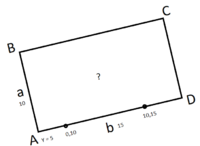Hi everyone,
I have a problem i can't figure out...
I want to calculate the centroid of a tilted rectangle in a coordinate system (See image) based on the following informations
I know the Y coordinate of corner A
I know the slope of the line b to the X axis based on two known points
I know lenght of a and b
From a given point on line b (x,y) i need to find the centroid... Is this possible?
So given an example what would the centroid be
a = 10
b = 15
Y coordinate of A is 5
The angle/slope of line b to X can be calculated from eg. 0,10 and 10,15
From coordinate 0,10 can i calculate the centroid? If possible will the same formula work if slope is negative?
All the best,
Kris
I have a problem i can't figure out...
I want to calculate the centroid of a tilted rectangle in a coordinate system (See image) based on the following informations
I know the Y coordinate of corner A
I know the slope of the line b to the X axis based on two known points
I know lenght of a and b
From a given point on line b (x,y) i need to find the centroid... Is this possible?
So given an example what would the centroid be
a = 10
b = 15
Y coordinate of A is 5
The angle/slope of line b to X can be calculated from eg. 0,10 and 10,15
From coordinate 0,10 can i calculate the centroid? If possible will the same formula work if slope is negative?
All the best,
Kris

